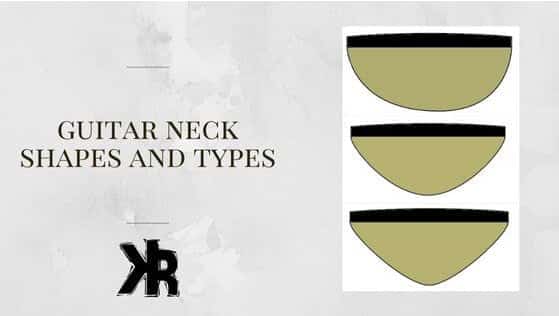Table of Contents
There are a lot of different guitar neck shapes available, and it can be tough to know which one is right for you.
Depending on your hand size, some will be more comfortable than others. This can have a huge impact on your ability to learn and perform some techniques.
In this Killer Rig article, we’ll explore the different neck shapes and which are the most common. We’ll also see which ones are best for beginners, intermediates, and advanced players. So, let’s find the perfect guitar neck shape for your playing style.
Why so many Guitar Neck Shapes?
A neck shape is also known as the profile or contour. It refers to the cross-sectional shape of the back of a guitar neck.
The part that your hand comes into contact with while playing. The neck profile influences how your hand grips the guitar. This directly affects your playing comfort, ease of fretting, and overall performance.
Different neck profiles cater to different hand sizes, finger lengths, and playing styles. This makes it crucial for guitarists to find the right shape for their preferences. The right neck profile can make playing more enjoyable and help reduce fatigue.
Conversely, the wrong one may cause discomfort or difficulty in reaching certain notes and chords. When examining a guitar neck profile, pay attention to its depth (thickness) and width. The depth is the distance between the back of the neck and the fretboard.
The width is the measurement from one side of the neck to the other. The combination of these dimensions, along with the curvature of the neck, determines the specific profile.
Most Common Guitar Neck Shapes
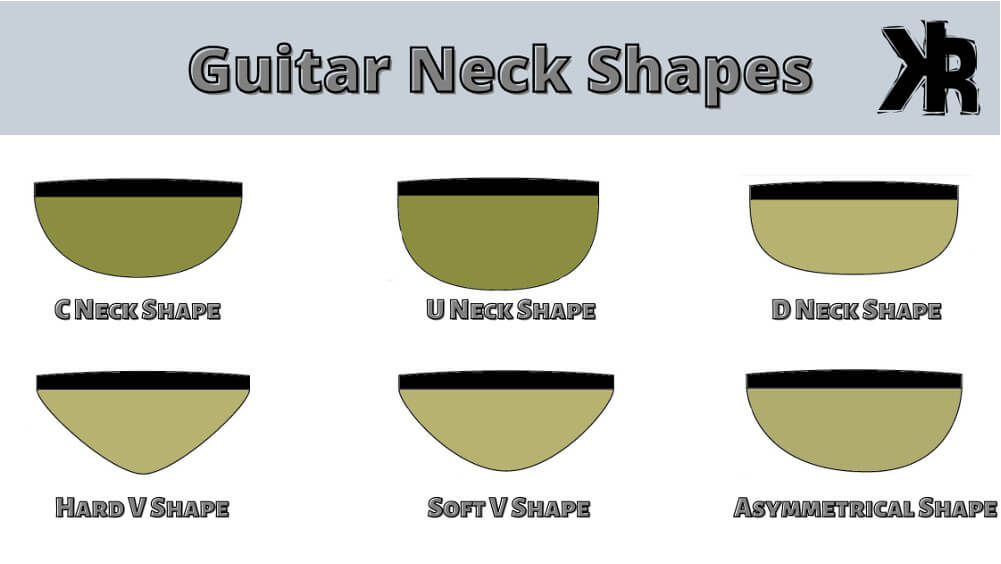
The neck on a guitar is one of the more important parts and is designed with a special purpose.
Here you find the most common neck shapes available. And within each section, you will find a 2-dimensional diagram to help you see what the shape looks like. It will help you determine what you might like best.
C-Shaped Neck and Low Profile
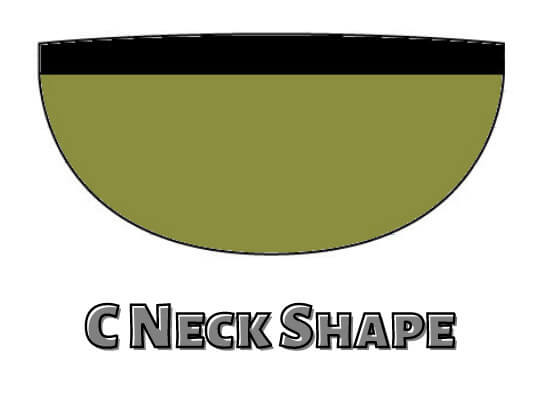
The C-shaped neck is one of the most common profiles, known for its comfort and versatility. It gets its name from its round and smoothly curved shape, similar to the letter C.
This shape is popular because it fits comfortably into the curve of the player’s hand, lending itself to a variety of playing styles.
Low Profile necks are a variant of the C-shape that is particularly popular in acoustic guitars.
This shape is essentially a flattened C-shape, providing a slimmer, faster feel that many players find comfortable, especially those transitioning from electric to acoustic guitars.
Low Profile necks are excellent for players with smaller hands or for those who prefer a less chunky feel.
V-Shaped Neck and Modified Low Oval
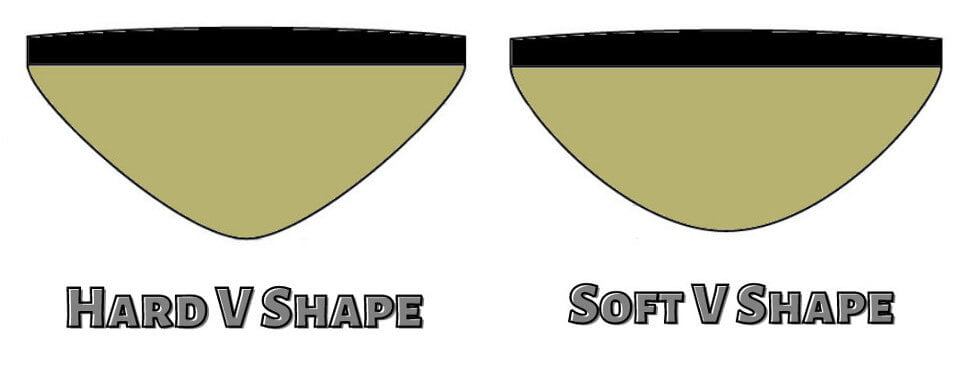
The V-shaped neck has a profile that forms a V in the middle. It’s a classic design often found on vintage guitars. Some players find the V-shape supportive for the thumb positioning during chord playing, while others appreciate the feel for stylistic reasons.
The V shape can be found in two main profiles:
- Rounded or soft.
- Hard V-neck shape.
A related acoustic guitar neck shape is the Modified Low Oval profile. It’s like a V-shape but with a more rounded bottom, similar to an oval.
The Modified Low Oval is a comfortable middle ground, retaining the feel of the V-shape while offering the comfort of a more conventional C-shaped neck.
U-Shaped Neck and Performing Artist

The U-shaped neck, also known as a baseball bat neck due to its bulk, is thicker with more mass than the C or V shapes. This profile is excellent for players who like to grip their hand around the neck and have a substantial feel.
The U-shaped guitar necks are not as common as the C or V, but they are still seen on some models.
This neck profile is thicker than the others and can be a bit more uncomfortable for some players. It was very popular on older models like the Fender Nocaster and Gibson Les Paul.
The Performing Artist neck shape found in many acoustic guitars could be seen as a counterpart to the U-shape. It offers a similar substantial feel but with a slimmer taper and slightly narrower width, providing a compromise between playability and grip.
D-Shaped Neck and PRS Neck Shapes
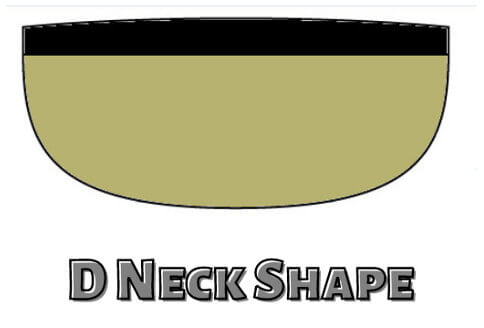
The D-shaped neck is characterized by a flat underside and rounded edges, forming a shape similar to the letter D when viewed in cross-section. This design is favored by many guitarists due to its efficient blend of speed and comfort.
The flat underside allows for swift, easy movement along the neck, ideal for complex solos and rapid chord transitions. Meanwhile, the rounded edges offer a comfortable grip, reducing hand fatigue during long playing sessions.
The Paul Reed Smith (PRS) electric guitars, renowned for their meticulous craftsmanship and high-quality sound, incorporate neck shapes that are analogous to the D-shape. Two primary neck profiles used in PRS guitars are the Pattern Regular and Thin.
The Pattern Regular neck shape, based on the company’s pre-factory, early 1985 design, offers a comfortable, medium-thickness profile similar to the D-shape. It provides a good balance between substantial grip and easy playability.
On the other hand, the Pattern Thin neck is PRS’s answer for players seeking a slimmer, faster feel. As the name implies, it’s thinner than the Pattern Regular, resembling a flattened D-shape.
This design facilitates rapid finger movement across the fretboard, making it ideal for lead guitarists and those with a preference for faster playing styles.
The Difference between C and U Neck Shapes
When it comes to guitar neck shapes, the C and U profiles represent two of the most common designs, each offering its own characteristics and advantages.
Understanding the differences between these two shapes can help you find a guitar that best fits your playing style and comfort level.
C-Shaped Neck
The C-shaped neck is named for its resemblance to the letter C in cross-section. This neck profile is one of the most common, particularly for electric guitars, because of its universal comfort and playability.
C-shaped necks are rounded and comfortable, typically providing a good fit for most hand sizes. These necks are often found on Fender guitars and are a favorite among many guitarists because of the balance they offer between playability and comfort.
They are versatile, fitting a wide range of musical styles, and are particularly suitable for blues and rock genres.
U-Shaped Neck
The U-shape, similar to a C-shaped neck, gets its name from its cross-sectional resemblance to the letter U. However, U-shaped necks are typically thicker and bulkier than their C-shaped counterparts.
These necks are often found on vintage guitars and are favored by guitarists who prefer a substantial grip. U-shaped necks offer a fuller, chunkier feel, providing a robust support that some players find enhances their control over the instrument.
This shape is excellent for rhythm guitarists or those who prefer a more traditional, vintage feel.
Asymmetrical Neck Shapes

Asymmetrical guitar necks have a specific design, thicker on one side (usually the bass side) and thinner on the other. This shape closely follows the natural position of a player’s hand, enhancing ergonomic fit and comfort.
The main advantage of an asymmetrical neck shape is its improved playability, allowing for a more natural hand position, especially useful for thumb-over techniques.
It provides a solid anchor for the thumb, while the thinner side facilitates swift finger movement across the fretboard. This design can boost speed and fluidity, particularly for complex chord shapes or lead lines.
However, neck shape preference varies widely among guitarists. It’s essential to try out an asymmetrical guitar neck to see if it suits your playing style and comfort.
It’s a significant innovation in guitar craftsmanship, continually refining each element for a better playing experience.
Pros and Cons of Neck Thicknesses
Every neck thickness presents unique advantages and disadvantages, impacting playability, comfort, and durability.
Thin Necks
Pros:
- Easy Playability: Thin necks are easier to navigate, allowing for faster and more fluid movement across the fretboard.
- Enhanced Speed: Ideal for quick chord transitions and complex solos. Thin necks are favored by lead guitarists and those who prefer a faster playing style.
Cons:
- Delicate Nature: Thin necks, while offering superior playability, can be delicate and more prone to warping under non-optimal conditions, such as temperature and humidity extremes.
- Sensitivity to String Tension: Thin necks can be sensitive to string tension, and certain guitar tunings may cause the neck to warp if not properly supported by an adequate truss rod.
Thick Necks
Pros:
- Durability: Thick necks are generally more robust and less likely to warp, making them more resilient to varying conditions.
- Sustain: Thick necks are often associated with better sustain and a fuller tone, which can be a significant advantage depending on the music style.
Cons:
- Difficulty in Playing: Thick necks can be challenging to play, especially for individuals with smaller hands. Bending and fast fret transitions can become particularly challenging.
- Comfort Issues: While providing a firm grip, thick necks can become uncomfortable after prolonged playing sessions, potentially leading to faster hand fatigue.
By understanding these pros and cons, you can make a more informed choice about the right neck thickness for your specific needs, playing style, and comfort.
How To Choose A Guitar Neck Shape
Navigating the plethora of guitar neck shapes available today can be quite daunting. Your choice can be influenced by various factors, including the style of music you wish to play and the size of your hands.
When selecting a guitar neck shape, consider the following:
- Your preferred music style.
- The size and comfort of your hands.
- The benefits of each shape.
- The speed demands of your playing style.
Understanding your needs can help narrow down the options, leading you closer to the ideal guitar neck shape. However, the best way to find a perfect fit is by trying out different shapes personally.
Remember, all guitar necks are not created equal. Each is designed to cater to different music styles and playability preferences uniquely. Over time, your tastes might evolve, so it’s wise to remain open to experimenting with different neck shapes.
Starting with common neck shapes like the C, V, and U can provide a solid foundation. From there, explore other shapes, focusing on what feels comfortable and facilitates your music style most effectively.
Your perfect guitar neck shape is the one that feels like an extension of your hand, enhancing your musical journey.
Neck Shapes for Small Hands
Certain guitar neck shapes better accommodate small hands. They typically feature a smaller fretboard radius and thinner profile than standard shapes.
The C-shaped slim or extra-slim necks are commonly recommended for small hands, offering easier navigation around the fretboard. The flatter D-shaped profile also serves well, facilitating an easy reach across the strings.
The asymmetrical profile, with varying thickness across its length, provides another excellent option. It can be tailored to fit a player’s hand shape, enhancing comfort and playability.
If you have small hands, it’s crucial to explore the neck profiles of guitars you’re considering. Numerous shapes can significantly enhance your playing experience.
Neck Profiles for Large Hands
For guitarists with larger hands, a thicker neck profile usually provides a better fit. While thinner necks aren’t off-limits, they might feel uncomfortable to some players.
The U-shaped profile is often recommended for larger hands. These thicker necks tend to offer better grip and support. A thicker asymmetrical neck might also prove beneficial, though personal experience will determine its suitability.
Common guitar neck shapes like C, U, and V should comfortably accommodate larger hands and support a wide range of playing styles. Ultimately, the best neck profile is one that feels comfortable, enhances your playability, and matches your musical style.
How to Identify Your Guitar’s Neck Shape
Having explored the various guitar neck shapes and types, you might be wondering about the profile of your current guitar. Identifying a guitar neck’s shape can be challenging, as many profiles closely resemble each other.
Specifications
The most reliable way to determine your guitar neck shape is by referencing the specifications provided by the manufacturer.
Typically, these details can be found on the manufacturer’s website, where the neck shape and type should be clearly indicated. Additionally, dealers and retailers carrying the brand may also provide this information.
Comparison
If these resources don’t yield the necessary details, you could compare your guitar neck to the diagrams presented in this guide. Carefully study your neck’s shape, looking for similarities between it and the profiles illustrated here.
For instance, by comparing the neck profiles of the PRS and Charvel guitars (as shown in the pictures below), I concluded that the Paul Reed Smith exhibits more of a soft V profile. While the Charvel leans towards a D shape.
The PRS neck, darker in color, contrasts with the Charvel’s wood grain, particularly noticeable in their thickness difference.
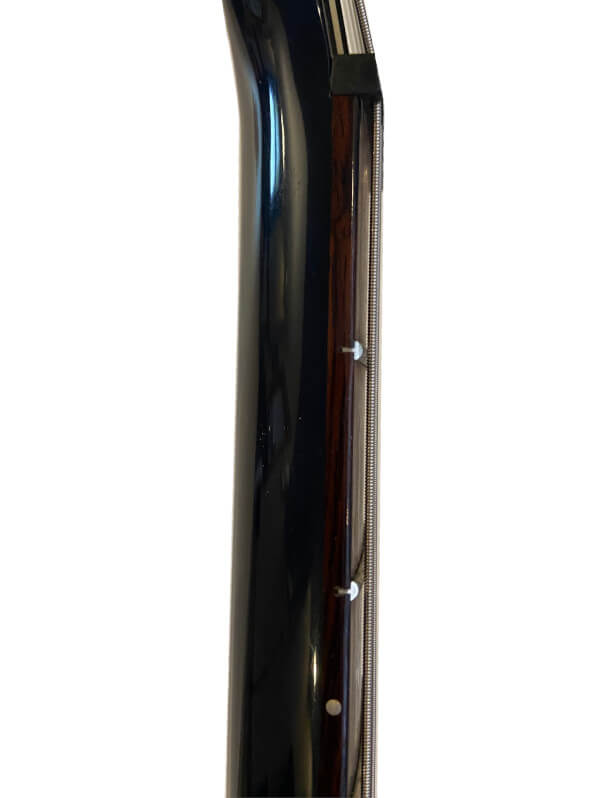
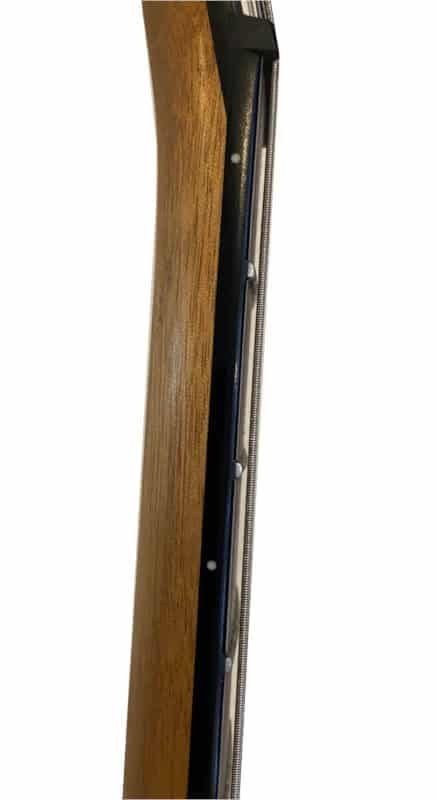
Conclusion
Finding the right guitar neck for your hand and the performance you desire is very important. Whether it’s bolt-on or set doesn’t matter as much as the type. So try a few and see what fits you best before ending up with an uncomfortable guitar neck.
FAQs
What guitar neck is best?
There is no correct answer to this question, as it depends on the player’s preference. Some guitarists prefer a C shape neck for its comfort and speed. Others may prefer a low oval or performing artist profile for its easier playability.
Ultimately, it’s up to the player to decide what guitar neck shape is best for them. Try out a few different neck profiles and see what is the most comfortable for your play style.
What neck shape is a Gibson Les Paul?
The Gibson Les Paul has normally used U shape profiles. But as time went by, players were fatigued by the baseball bat size. They eventually moved to a D shape and have had different versions of the profile.
You can find some that are smaller and even asymmetrical depending on the year and make. Modern guitars tend to adjust to new players’ tastes and requirements.

